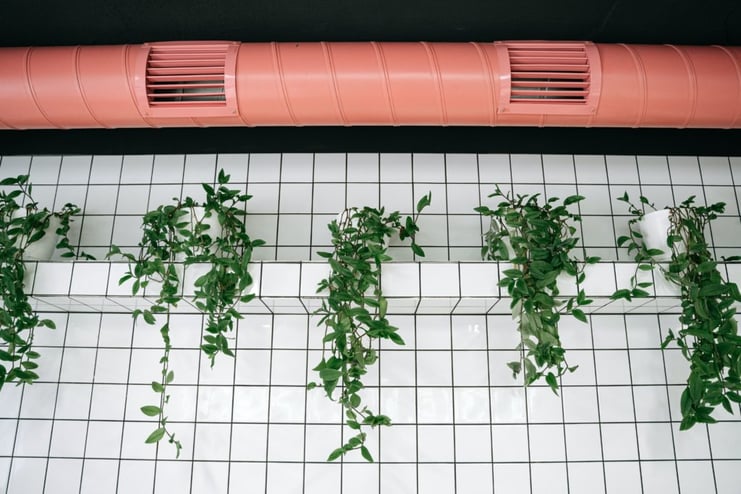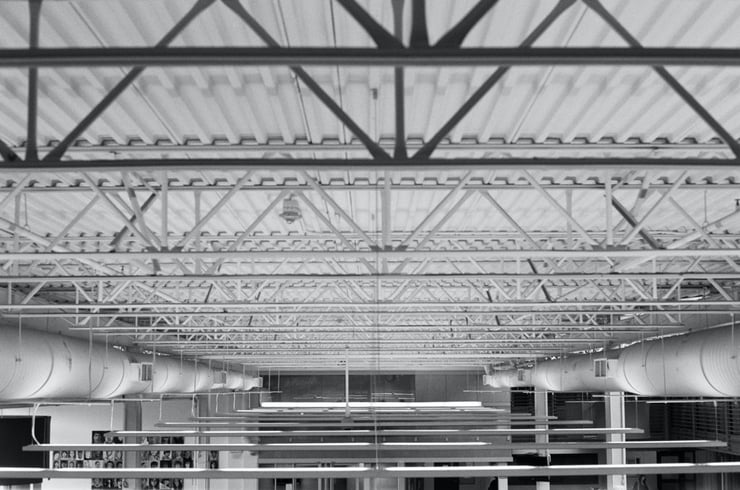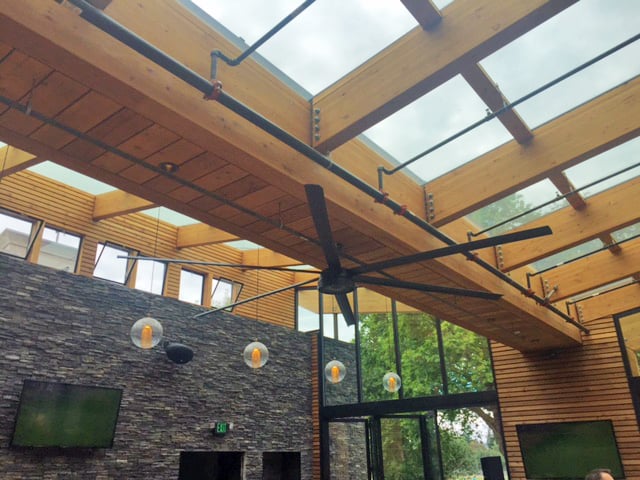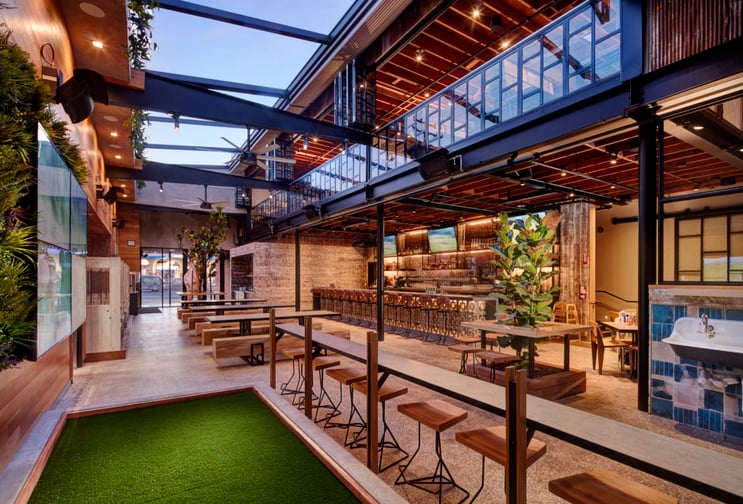Recent January wildfires in California have highlighted what has become an undeniable reality:...
The Effects of Poor Ventilation on Health in the Workplace
According to Professor Joseph Allen at Harvard's School of Public Health, humans spend an average of 90% of their time indoors. Therefore, we must be aware of air quality and proper ventilation. Allen, director of Harvard's Healthy Buildings Program, says a healthy room should rotate 5-6 air changes per hour (ACH). This means air should completely recirculate throughout a space 5-6 times every hour. Despite these numbers, most buildings only rotate 1-3 ACH. What’s even more alarming is how homes rotate an average of less than one ACH!
Nowadays, people are no longer in the dark about the importance of proper ventilation. They understand the importance of healthier and higher air quality. In this blog, we'll explore the causes and effects of poor ventilation on people's health. We'll also explore various solutions to inadequate ventilation.
What Causes Poor Ventilation in the Workplace?

Photo by Ivan Samkov from Pexels
In general, buildings are created with energy efficiency, business objectives, and the bottom line in mind. Many businesses fail to seriously consider their ventilation systems and the overall health ramifications that accompany poor ventilation. Two main causes of poor air ventilation are a lack of circulation within a space and an inadequate design of mechanical ventilation systems.
Poor Air Circulation
First, poor air circulation refers to a lack of air movement altogether. This means the air is just sitting stagnant in a space. Remember, a healthy space should rotate air at a rate of 5-6 air changes per hour. We can combat the problem of poor air circulation with a very simple solution: opening a window. This will allow the outdoor air to flow throughout your space, creating proper air ventilation, which flushes out odors, dust, and other indoor pollutants.
Additionally, consider adding portable air purifiers with HEPA filters or turning on ceiling fans to remove the stagnant air. These simple, manageable steps will help make a huge difference in combating the effects of poor ventilation in your space.
Poorly Designed Ventilation System
Second, poor ventilation system designs refer to ventilation systems that aren’t properly or effectively pushing out air. This is caused by poor placement of outdoor intakes or blocked vents due to room arrangements. Indoor air pollutants and contaminants often exacerbate these system shortcomings. On top of that, poor air circulation can exacerbate these pollutants and contaminants.
Effects of Poor Ventilation on a Building

Photo by Everett Bumstead from Pexels
Sick Building Syndrome
Sick Building Syndrome (SBS) describes when occupants experience acute discomfort and health issues directly linked to a building's indoor environment. This occurs when poor ventilation in a building creates a rise in carbon dioxide levels, therefore creating a significant increase in fine aerosol particles (contaminants) in the air. These fine aerosol particles are ingested when talking, sneezing, coughing, and or breathing.
Below are the types of airborne contaminants that can also contribute to poor air quality. These indoor contaminants can cause many health issues when combined with poor ventilation.
Other Airborne Contaminants Include:
- Tobacco smoke
- Carpet and other office furnishings
- Bathroom air fresheners
- Formaldehyde from laminate flooring or other pressed wood products
- Cleaning materials
- Paints
- Glues
- Copy machines
- Dirty ventilation systems
- Pesticides
- Gas stoves
- Improperly vented heater sources
- Outdoor environmental factors, including pollen
Effects of Poor Ventilation on Health

Photo by Marcus Aurelius from Pexels
Significantly impaired cognitive function is directly linked to poor air ventilation in environments, such as offices and schools. This includes the inability to think clearly and creatively properly. Other adverse health effects of poor ventilation include:
- Headaches
- Fatigue
- Trouble concentrating
- Respiratory issues, including shortness of breath and nose, eyes, throat and lung irritation
- Trouble with analytical thinking
Additionally, indoor air pollution and Sick Building Syndrome have also been linked to more serious health problems, which include asthma, Legionnaires Disease, hypersensitivity, pneumonitis, humidifier fever, and even cancer due to asbestos.
To learn more about the adverse effects of poor ventilation from SBS, check out this factsheet from the EPA.
4 Ways to Address the Effects of Poor Ventilation

Shelter Lounge, Green Lake – Seattle, WA
High, indoor air quality is not a luxury, it’s a necessity. In fact, the EPA, CDC, OSHA, NIH, and ASHRAE all require that employers prioritize the health and comfort of their employees. These organizations have set IAQ standards for eliminating contagions, viruses, and pollution, as well as managing humidity and heat. This is why it is crucial to prioritize air quality at all times--your employees' health depends on it.
To address the effects of poor ventilation and keep your employees’ health at the forefront, consider investing in ceiling fans and HVAC systems, researching the building’s humidity levels, and using portable air purifiers.
1 – Investing in Ceiling Fans
First, if you work in an industrial environment, like a warehouse, ceiling fans will greatly improve your indoor air quality. They’ll even help you meet Indoor Air Quality (IAQ) standards set by federal agencies (mentioned above), which keeps businesses accountable for prioritizing employee health, comfort, and performance. Additionally, you may also want to consider exhaust fans to help push stale, indoor air out.
Moreover, considering the current climate surrounding COVID-19, there is a need for employers to keep warehouse air quality clean and healthy for their employees. Recently, MacroAir Technologies partnered with the Air Movement and Control Association International (AMCA International) to fund their study on how large-diameter fans create healthier warehouses. We’ll discuss this more in-depth in the next main section.
2 – Determine Your HVAC Needs
Next, if you’re thinking about adding an HVAC system (alongside ceiling fans), first consider the correct size and cooling needs you’ll need for your space. Make sure your HVAC/air conditioner units will fit your space because if it’s too big, it’ll cause your system to run for shorter amounts of time (i.e. short cycling).
If short cycling occurs with heating, the fan will not run long enough. However, if short cycling occurs with cooling, it’ll create smaller bursts of air, which will cause the system to dehumidify and provide minimal cooling. Heating and cooling with the wrong-sized HVAC unit won’t provide proper ventilation.
3 – Know Your Ideal Humidity Levels
Considering humidity levels in industrial environments is also extremely important for employee health. According to the Harvard School of Public Health, the ideal humidity level in a room is 40%-60%. For your respiratory system to properly function, humidity levels must meet these optimal levels. Furthermore, if humidity levels fluctuate above or below the 40-60% range, it will cause adverse effects on your health.
When Humidity Levels Are Too High or Too Low
When humidity levels are below the ideal range of 40%-60%, it can allow viruses within your body to live longer, allowing for easier transmission. Additionally, low humidity levels slow the rate at which droplets evaporate, thus allowing viruses to live longer in the air.
When humidity levels are above the ideal range of 40%-60%, it can cause mold. Mold is not something you or any building wants to mess with! According to the Mayo Clinic, mold can cause major allergic reactions and has been linked to asthma and breathing restrictions. Furthermore, if a building's lack of natural ventilation causes toxic mold, this can be even more dangerous for your health.
4 – Add Portable Air Purfiers
Lastly, if you’re not able to open a window or use a ceiling fan, portable air purifiers can help with creating more ventilation. Consider air purifiers with a HEPA filter, which will help remove up to 99.97% of air particles, including fine aerosol particles. Be mindful, however, that the room size will dictate the number and size of air purifiers needed to work effectively in your space.
AMCA Study Shows Ceiling Fans Help Create Healthier Warehouses
As previously mentioned, AMCA International, in collaboration with Concordia University, and an elite team of scientists and engineers, published a report regarding a year-long study on the effects of running large-diameter ceiling fans in warehouse environments during COVID-19. Their goal was to understand how large-diameter ceiling fans (over 7 ft.) affected COVID-19 exposures in warehouses by conducting over 200 simulations in a 330 ft. 150 ft. 28 ft. warehouse (Ivanovich, Gunzner, & Arnold, 2021).
AMCA Report At A Glance
Confirmations:
- Operating a large-diameter ceiling fan (LDCF) at the highest speed in a downward direction is the most effective option to help reduce the concentration of airborne particles from speaking loudly (shouting) in a sparsely populated warehouse setting (Wang, 2021).
- There was also a reduction in airborne particle concentration when a fan was running in reverse at the highest speed in a sparsely populated warehouse setting (not as great of a reduction compared to the fan running in a downward direction) (Wang, 2021).
- Operating a ceiling fan at a slower speed will show a slight reduction in the concentration of airborne particles from speaking loudly when occupants are close to the fan, although not as well when at the highest speed and or when outside the fan region (Wang, 2021).
- Reducing fan speeds and running them in reverse could slow all airflow, thus actually increasing the air concentration (Wang, 2021).
Guidance:
- In summer months, despite how far the workers are from the fans, operate the fans downward at the highest appropriate speed (while still keeping people comfortable) in either direction – forward or reverse (Wang, 2021).
- In winter months, despite how far the workers are from the fans, operate the fans downward at the highest appropriate speed (while still keeping people comfortable) OR operate the fans in reverse at the highest appropriate speed (Wang, 2021).
- Open windows and doors in your warehouse and operate ceiling fans wherever possible (Wang, 2021).
- Do not place employees directly next to each other for long periods (Wang, 2021).
- Operate ceiling fans at the highest possible rate in either direction while still keeping your employees comfortable.
Our team at MacroAir proudly stands behind helping to create healthy, well-ventilated environments for all people. Our HVLS fans are certainly a necessary addition to all warehouse spaces.
MacroAir Cares – #MacroAirCares
MacroAir Technologies was a proud partner in helping to fund AMCA’s recent study. They stand firmly behind helping to create healthy and well-ventilated environments for all. Additionally, they truly care about your employees and their well-being.
MacroAir offers large ceiling fans for your commercial and industrial facilities ranging from 6-24 feet in diameter. With the addition of fans, air will be constantly moving throughout the space. MacroAir's helpful customer care representatives are happy to help you find the exact fan perfect for your facility’s needs.
Not only will a ceiling fan increase natural ventilation, but it will also keep workers healthier. In fact, a ceiling fan will work with an existing HVAC system to cool the space more efficiently. These things combined create a better overall work environment, thus helping companies with the bottom line.
Next Steps

Blue Motif Crack Shack Costa Mesa
With humans spending an average of 90% of their time indoors and knowing the effects poor air ventilation can have on health, you now know how crucial it is to be aware of indoor air quality. By exploring the causes and effects of poor ventilation on people’s health, along with how to fix indoor air quality issues, we can provide a healthier work environment for all people and reduce the health risks of poor ventilation. Remember, air quality is an essential requirement, not a choice.
Start Today - Do Not Wait
We can help you get started right here, right now. It is time wasted if you are not working towards solving your ventilation problem today. And poor ventilation is a MAJOR problem. Assess whether your employees are comfortable, healthy, and productive - or sluggish, sick (high rate of absenteeism), and unmotivated. And let’s be honest, we all want comfortable, healthy, and productive employees. If they are not, ventilation issues may be to blame.
Find out more about MacroAir's HVLS fans today, and improve your ventilation problems easily.
References
Ivanovich, M., Gunzner, A., & Arnold, S. (2021). AMCA COVID-19 Guidance for Large-Diameter Ceiling Fans. AMCA International.
Wang, L. (2021, October 26). AMCA COVID-19 Guidance for Large-Diameter Ceiling Fans. Cube: AMCA covid-19 guidance for large-diameter ceiling fans. Retrieved November 8, 2021, from https://users.encs.concordia.ca/~leonwang/moodle/mod/forum/discuss.php?d=13.


